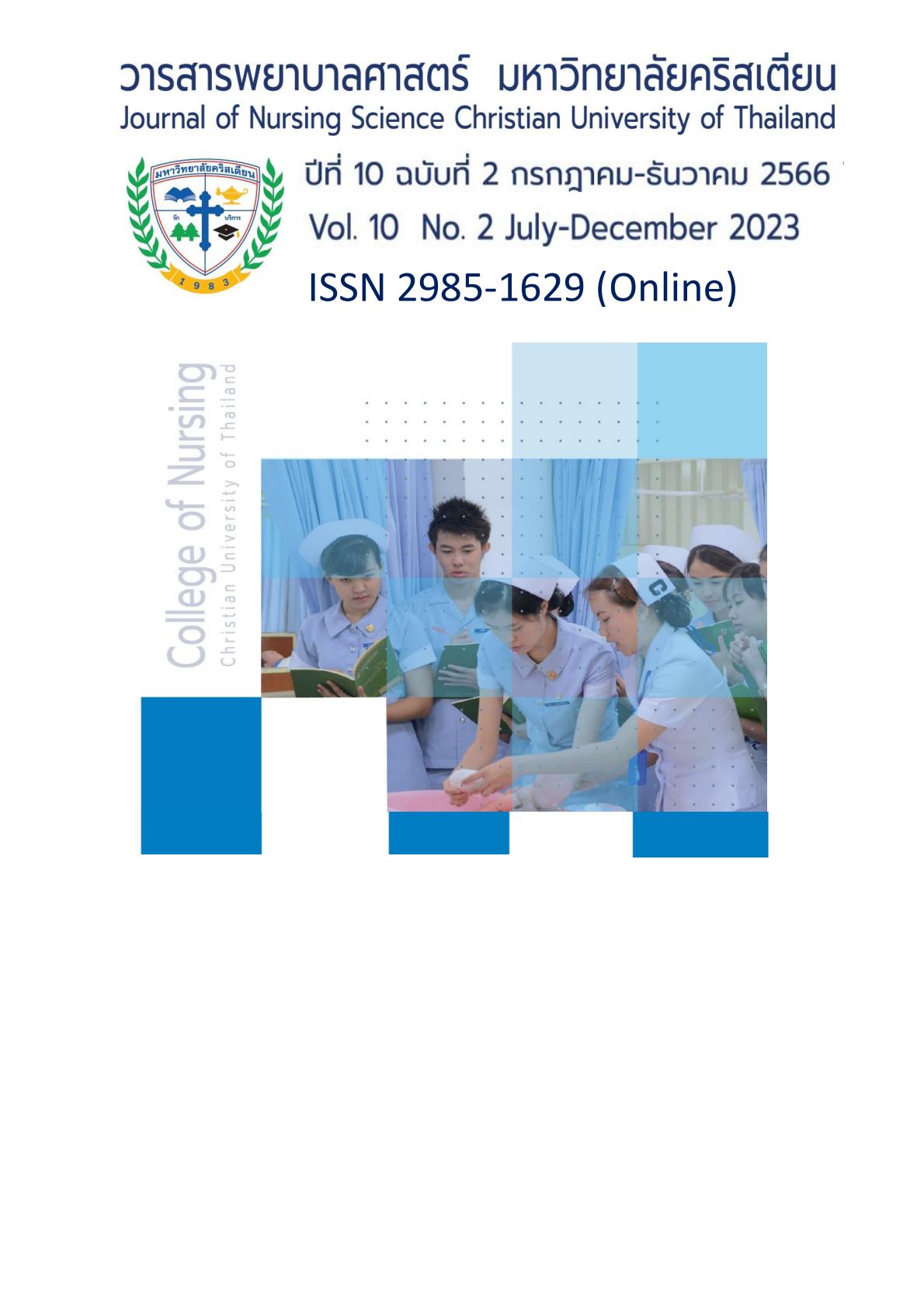บทบาทของพยาบาลกับการใช้ปิโตรเลียมเจลลี่เพื่อป้องกัน และดูแลแผลกดทับ: การทบทวนวรรณกรรม
คำสำคัญ:
บทบาทของพยาบาล, ปิโตรเลียมเจลลี่, แผลกดทับ, ทบทวนวรรณกรรมบทคัดย่อ
แผลกดทับยังคงเป็นปัญหาสำคัญที่ส่งผลต่อคุณภาพชีวิตของผู้ป่วยและญาติ พยาบาลเป็นผู้ที่ดูแลผู้ป่วยอย่างใกล้ชิดที่สุดจึงมีบทบาทสำคัญในการช่วยป้องกันการเกิดแผลกดทับและดูแลแผลกดทับ พยาบาลจำเป็นต้องมีความรู้ในการจัดการกับแผลกดทับเพื่อช่วยให้แผลกดทับดีขึ้น การดูแลผิวหนังของผู้ป่วยถือว่าเป็นหนึ่งในวิธีการดูแลและป้องกันแผลกดทับ มีผลิตภัณฑ์หลายชนิดที่ใช้ดูแลผิวหนังเพื่อลดการเกิดและช่วยรักษาแผลกดทับ แต่ผลิตภัณฑ์บางชนิดมีราคาค่อนข้างแพงและหาซื้อได้ยาก จากการทบทวนวรรณกรรมพบว่าการใช้ปิโตรเลียมเจลลี่เป็นอีกทางเลือกที่เหมาะสมในการดูแลผิวหนังเพื่อป้องกันและดูแลแผลกดทับ เนื่องจากมีราคาถูกหาซื้อได้ง่าย และมีความปลอดภัยหากใช้อย่างถูกต้อง บทความวิชาการนี้มีวัตถุประสงค์เพื่อนำเสนอบทบาทของพยาบาลในการนำปิโตรเลียมเจลลี่ไปใช้ในการป้องกันการเกิดแผลกดทับและดูแลแผลกดทับ รวมทั้งการให้คำแนะนำแก่ผู้ป่วยและญาติเพื่อการดูแลต่อเนื่องอันจะส่งผลต่อคุณภาพชีวิตที่ดีของผู้ป่วยต่อไป
เอกสารอ้างอิง
คู่ขวัญ มาลีวงษ์. (2564). การพัฒนาและประเมินผลของการใช้แนวปฏิบัติทางการพยาบาลเพื่อการป้องกันการเกิดแผลกดทับสำหรับผู้ป่วยอายุรกรรม โรงพยาบาลวชิรพยาบาล. วชิรสารการพยาบาล, 23(1), 15-30.
พัฒนา พึ่งศิริ. (2559). ผลของการใช้แนวทางปฏิบัติการดูแลผิวหนังผู้ป่วยที่มีปัญหาการควบคุมการขับถ่าย ในผู้ป่วยที่เสี่ยงต่อภาวะผิวหนังอักเสบจากการสัมผัสอุจจาระ/ปัสสาวะ. วารสารวิชาการแพทย์เขต 11, 30(1), 59-67.
อรนุช มกราภิรมย์ และอันธิกา คะระวานิช. (2563). การพัฒนาแนวปฏิบัติทางการพยาบาลสำหรับป้องกันการเกิดแผลกดทับในโรงพยาบาลตราด. วารสารกองการพยาบาล, 47(1), 139-152.
Adekunle, A. S., Oyekunle, J. A. O., Ola, I. J., Obisesan, O. R., & Maxakato, N. W. (2018). Determination of polycyclic aromatic hydrocarbons (PAHs) and organochlorine pesticides (OCPs) in some personal care products in Nigeria. Toxicology Reports, 5, 994-1001. https://doi.org/
1016/j.toxrep.2018.10.003
Al Aboud, A. M., & Manna, B. (2023). Wound pressure injury management. https://www.ncbi.nlm.nih.gov/books/NBK532897/
AlKharfy, T., Ba-Abbad, R., Hadi, A., & AlFaleh, K. (2014). Use of topical petroleum jelly for prevention of sepsis in very low-birthweight infants: A prospective, randomised controlled trial. Paediatrics and International Child Health, 34(3), 194-197. https://doi.org/10.1179/2046905514Y.0000000117
American Academy of Dermatology Association. (2023). Proper wound care: How to minimize ascar. https://www.aad.org/public/everyday-care/injured- skin/burns/ skin/burns/wound-care-minimize-scars
Baltz, J. O., Franciosi, E. B., & Wiss, K. (2020). Petroleum jelly baths: A tip for easy emollient application. Pediatric Dermatology, 37(5), 964-965. https://doi.org/10.1111/pde.14256
Bergstrom, N., Demuth, P. J., & Braden, B. J. (1987). A clinical trial of the braden scale for predicting pressure sore risk. Nursing Clinics of North America, 22(2), 417-428. https://doi.org/10.1016/S0029-6465(22)01289-0
Borojeny, L. A., Albatineh, A. N., Dehkordi, A. H., & Gheshlagh, R. G. (2020). The Incidence of pressure ulcers and its associations in different wards of the hospital: A systematic review and meta-analysis. International Journal of Preventive Medicine, 11. https://doi:10.4103/ijpvm.IJPVM_182_19
Chepuri, R., Shah, J., Sheinin, Y., & Kurman, J. (2020). Exogenous lipoid pneumonia: When petroleum Jelly does more than just moisturize. Chest, 158(4), A1575-A1576. https://doi.org/10.1016/j.chest.2020.08.1417
Czarnowicki, T., Malajian, D., Khattri, S., Correa da Rosa, J., Dutt, R., Finney, R., & Guttman-Yassky, E. (2016). Petrolatum: Barrier repair and antimicrobial responses underlying this "inert" moisturizer. The Journal of Allergy and Clinical Immunology, 137(4), 1091–1102.e7. https://doi.10.1016/j.jaci.2015.08.013
Environmental Working Group. (2023). Vaseline original healing jelly. https://www. ewg.org/skindeep/products/992530-Vaseline_Original_Healing_Jelly/
Espejo, E., Andrés, M., Borrallo, R. M., Padilla, E., Garcia-Restoy, E., & Bella, F., (2018). Bacteremia associated with pressure ulcers: A prospective cohort study. European Journal of Clinical Microbiology & Infectious Diseases, 37, 969-975. https://doi.org/10.1007/s10096-018-3216-8
Gutman, A. B., Kligman, A. M., Sciacca, J., & James, W. D. (2005). Soak and smear: A standard technique revisited. Archives of Dermatology, 141(12), 1556-1559. https://doi:10.1001/archderm.141.12.1556
Heyward, J., Padula, W., Tierce, J. C., & Alexander, G. C. (2018). The value of U.S. pharmacopeial standards: A review of the literature. Journal of Pharmaceutical Sciences, 107(10), 2611-2617. https://doi.org/10.1016/j.xphs.2018.06.004
Ifegwu, O. C., & Anyakora, C. (2015). Polycyclic aromatic hydrocarbons: Part I. Exposure. Advances in Clinical Chemistry, 72, 277-304. https://doi.org/10.1016/bs.acc.2015.08.001
Jayakumar, K. L., & Micheletti, R. G. (2017). Robert Chesebrough and the dermatologic wonder of petroleum jelly. JAMA Dermatology, 153(11), 1157-1157. https://doi:10.1001/jamadermatol2017.3544
Kang, H., Choi, J., & Lee, A. Y. (2004). Allergic contact dermatitis to white petrolatum. The Journal of Dermatology, 31(5), 428-430. https://doi.org/10.1111/j.1346-8138.2004.tb00698.x
Kuribayashi, K., Takeuchi, H., Endo, Y., Tomita, S., & Nishikouri, Y. (2018). Macrogol versus Vaseline in the treatment of superficial sacral pressure ulcers: A retrospective, Comparative study. An Official Journal of the Japan Primary Care Association, 41(2), 60-64. https://doi.org/10.14442/generalist.41.60
Li, Z., Lin, F., Thalib, L., & Chaboyer, W. (2020). Global prevalence and incidence of pressure injuries in hospitalised adult patients: A systematic review and meta-analysis. International Journal of Nursing Studies, 105, 103546. https://doi.org/10.1016/j.ijnurstu.2020.103546.
National Clinical Guideline Centre (UK). (2014). The prevention and management of pressure ulcers in primary and secondary care. London.
National Eczema Association. (n.d.) 100% Pure petroleum jelly. https://nationaleczema.org/blog/product/org/blog/product/100-pure-petroleum-jelly/
National Pressure Ulcer Advisory Panel. (2016). National Pressure Ulcer Advisory Panel (NPUAP) announces a change in terminology from pressure ulcer to pressure injury and update the stages of pressure injury. Washington.
Never Pressure Injury. (2022). Automated pressure injury prevention system.https://www.neverpressureinjury.com/about-us
Pan Pacific Pressure Injury Alliance. (2019). Prevention and treatment of pressure ulcers/injuries: Quick reference guide. European pressure ulcer advisory panel, National pressure injury advisory panel and pan pacific pressure injury alliance.
Pires, D., Soule, H., Bellissimo-Rodrigues, F., De Kraker, M. E. A., & Pittet, D. (2019). Antibacterial efficacy of handrubbing for 15 versus 30 seconds: EN 1500-based randomized experimental study with different loads of Staphylococcus aureus and Escherichia coli. Clinical Microbiology and Infection, 25(7), 851-856. https://doi.org/10.1016/j.cmi. 2018.10.012
Pittet, D. (2005). Clean hands reduce the burden of disease. The Lancet, 366(9481), 185-187. https://doi.org/10.1016/S0140-6736(05)66886-9
Sethi, A., Kaur, T., Malhotra, S. K., & Gambhir, M. L. (2016). Moisturizers: The slippery road. Indian Journal of Dermatology, 61(3), 279. https://doi:10.4103/0019- 5154.182427
Tachibana, T., Imafuku, S., Irisawa, R., Ohtsuka, M., Kadono, T., & Fujiwara, H., (2016). The wound/burn guidelines–2: Guidelines for the diagnosis and treatment for pressure ulcers. The Journal of Dermatology, 43(5), 469-506. https://doi.org/10.1111/1346-8138.13274
Tam, C.C., & Elston, D.M., (2006). Allergic contact dermatitis caused by white petrolatum on damaged skin. Dermatitis, 17(4), 201-3. https://doi: 10.2310/6620.2006.06010
The Registered Nurses' Association of Ontario. (2005). Risk assessment & prevention of pressure ulcers. Nursing Best Practice Guideline. https://rnao.ca/sites/rnao-ca/ files/Risk Assessment and Prevention of Pressure Ulcers.pdf
Wang, X., Yu, Z., Zhou, S., Shen, S., & Chen, W. (2022). The Effect of a Compound Protein on Wound Healing and Nutritional Status. Evidence-Based Complementary and Alternative Medicine, 2022. Aricle ID 4231516. https://doi.org/10.1155/2022/4231516
Zahara, Y., Dewi, R., & Saptarini, E. (2016). Efektifitaspenggunaan white petroleum jelly untuk perawantalukatekan stage1 di rawatinapsiloam hospitals lippo village. Indonesian Journal of Nursing Health Science, 1(01). 15-32.



